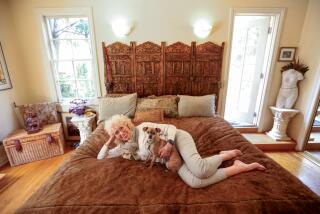Water Takes On New Perspective as Decorative Element in Homes : Waterworks: Decorators are incorporating water into decorating schemes, such as watercourses and recirculating fountains.
- Share via
Water running continuously, or spurting, or lying in a pool. It’s enough to send a homeowner scurrying to find a plumber. But along comes Marshall Watson, who lends a new perspective.
Watson, a decorator in New York, uses both moving and still water as a decorative element in living rooms, garden rooms, foyers and bathrooms.
“People aren’t used to having moving water indoors, but it’s akin to a dose of fresh, clean, pure air in conveying a refreshing and calming sense of nature,” he says.
Watson has made use of water quite simply--by pouring it into a large, shallow bowl and putting a sculpture or plant on a pedestal in the middle. He has also orchestrated complicated installations. In a long, wide foyer, for example, he designed a watercourse made of two shallow, 6-inch-wide troughs recessed in a marble floor. A recirculating pump and under-floor pipes created the illusion of water flowing down one side, stopping and flowing back on the other side.
The watercourse cost $20,000, excluding the marble. Watson hopes some day to find a wealthy client willing to underwrite his idea for a clear glass wall or floor which, at the flick of a switch, becomes opaque with a sheet of bubbly water. It requires air jets, a pump and a leakproof glass installation. Similar installations have been done commercially, albeit at great expense.
For those with more modest means who favor water in their decor, there are ready-made recirculating fountains.
Fountains are traditional in many cultures, according to Watson. Mediterranean homes were designed around a central atrium with a fountain. Roman baths used water as decoration in many ways. In Morocco, a shallow pool made of glazed tiles is common inside the home, and the Japanese use flat, still pools or table-top arrangements in the home.
Recirculating decorative wall fountains require no plumbing and take only a few gallons of water. “You just hang them up and plug them in,” says Skip (Graham) Brown, president of Florentine Craftsmen Inc. of New York. Prices for his company’s designs range from about $1,000 to $1,600. Brown says a number of companies make fountains in ceramic tile, plastic, aluminum or lead. In metal fountains, lead is more durable and more expensive, but aluminum is lighter.
You don’t have to install a fountain to get decorative benefits from water, says Watson. For a party, he suggests this centerpiece on a white tablecloth: Several small fishbowls from the five-and-ten filled with pale blue tinted water and a gardenia afloat in each. Between the bowls, place votive candles.
Water and the bath are, of course, inextricably linked. You can enhance the joy of bathing by installing halogen lighting over the bathtub. “I place a pale turquoise gel in front of the beam and it gives the water special sparkle,” says Watson.
There are faucets for bathroom sinks and tubs that deliver water in novel ways. The Kohler Co., for example, has introduced faucets that deliver water in sheets rather than in the usual circular stream. The idea is to duplicate the feeling of looking at a waterfall, says Gary Felsinger, Kohler’s product manager for faucets.
“The most dramatic product is the open channel or flume spout which is open at the top. Instead of coming out of the end of a closed pipe, the water flows through an open flat area. The flow rate is controlled so the water is dispersed equally along both sides,” he says. The cost is about $600, twice that for a conventional faucet of comparable quality.
Water appeals to all of the senses, and Kohler is investigating bath products that take advantage of this fact, Felsinger says. Among ideas being explored by the company is delivering water to the middle of the tub, perhaps fountain-like. What the company calls “soft water” would appeal to the sense of touch. “You’d do it with air,” he says.
The principle is the same as whirlpool bath jets, which mix water and air to create bubbles. The therapy comes when the bubbles break as they hit the skin.
Distributed by AP Newsfeatures.






